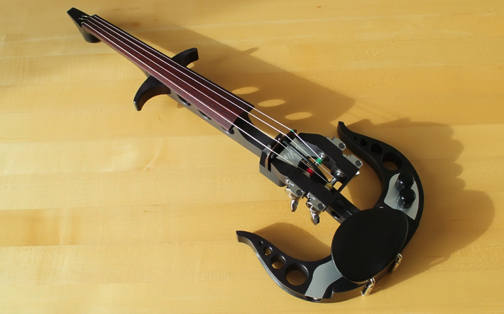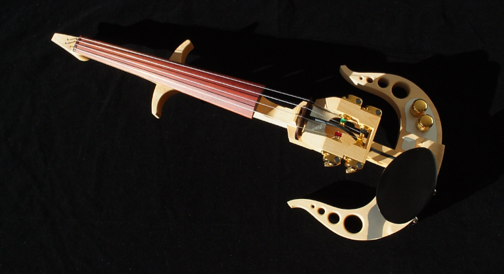E. F. Keebler Musical Instruments
The Filament: a new pinnacle of tone and ergonomics.
The Filament is the product of several years of grueling cycles of intensive research, CAD work, prototyping, machining, assembly, and testing. This new model distills my decades of professional electric-violin-making experience into an instrument that is better-sounding, more precisely shaped, lighter in the left hand, more affordable, and faster to produce than anything I have ever offered. This is a truly professional-caliber violin that is meant for every violinist.
How can I offer mid-tier pricing on a top-tier violin? By using a high-precision CNC mill to produce all the parts in-house, with far more efficiency than ever before. I still assemble, hand-finish, wire, set up, and voice every violin completely by myself -- I apply my high standards and my quarter-century of experience making electric violins to every single instrument. A high-quality European-made hard case is included. (Please note that I do not include a shoulder-rest, bow, instrument cable, or any other accessories.)
Currently-available Filament violins!
- A Filament with a linseed-oil finish over natural maple and bloodwood fingerboard is available at the Electric Violin Shop with free shipping.
Lighting.
Optional interchangeable magnetically-attached lighting modules are now available! They are powered by a small 10180 lithium-ion battery that fits easily and securely between the two halves. Despite the secure magnetic connection, changing out the battery -- or the entire module -- is still easy and fast, due to the carefully-adjusted balance of forces between the pull of the magnets and the push of the electrical contacts. I am currently offering one type of module with surface-mounted LEDs, and another with designs carved through the aluminum plates and into frosted edge-lit acrylic beneath. Each module can have one or more lighting functions, with each half being controllable independently (this lets you turn on just the side facing your audience, doubling your battery life). Small (3mm) LEDs are single-color, while larger (5mm) ones can be multi-color (RGB) with either auto-changing colors or switches for each primary color to produce seven blended colors. Customization of the LED layout or the engraved design is a possibility too; contact me for more information.
Timbre.
What initially got me interested in making electric violins (way back in the 1990s) was an experience with a friend’s beautifully-crafted instrument that unfortunately had a very thin, bright, buzzy sound. I thought I could do better, and after first making electromagnetic pickups for my early Tubular Electric Violins and then pivoting to piezoelectric technology, I achieved that goal with dual-pickup bridges whose mix (and thus timbre) could be changed with a blend knob: a really sweet acoustic-like sound emerged in one spot near each end of the blend knob’s travel. My piezoelectric pickups have always been optimized for use with guitar amplifiers; you may require a “direct box” or additional equalization if you attempt to connect directly to a PA system or mixing board.
My parallel career doing tonal work on pipe organs has vastly improved my ability to listen to and analyze timbre, and this inspired me to dramatically expand the potential of my violin pickups. After much thought and experimentation, I created the Filament’s multi-axis pickup system: an array of pickup elements inside the bridge that add and subtract harmonics to shape the violin’s timbre. While some other makers’ pickups dedicate elements to specific strings, I have refined my bridge geometry and materials to optimize tonal balance across all the strings and to impart a decidedly acoustic character when playing down the G string; and then placed the pickup elements at various locations inside the bridge in ways that allow each one to react differently to all the strings and with a user-adjustable level of contribution to the overall timbre. This allows you to give your Filament a voice that’s unique to you!
These tonal adjustments are not meant to be used on-stage: not every combination of settings will give good results, but patient exploration will yield a variety of distinct and rewarding tonalities. The controls are a set of tiny trimmer potentiometers on the underside of the bout, which can be turned with a tool included with the violin. I carefully set up each violin with a woody and lyrical “acoustic” timbre so that the violin is completely ready-to-play; be sure to take a photo of the current control positions before changing them (don’t worry, I keep such a photo in my records for every instrument I make), and take another photo whenever you find a timbre that you really like.
I provide a pair of large knobs on the top of the lower bout so that you can quickly and easily regulate volume and treble during a performance.
Form.
Throughout the Filament’s design process, I paid close attention to making those parts of the instrument that the player interacts with, true to the measurements of an acoustic violin. (Of course, even though 4/4 violins have highly-standardized measurements, they’re far from completely standardized; and I spent long hours consulting reference books and violin-maker forums, teasing out subtle details that allowed me to make final decisions on many measurements.)
The Filament sports a newly-refined neck. As on all my violins, it is finished with nothing but linseed oil (beware of lacquered necks as their friction can impede the free movement of your left hand). Filament #1 is equipped with a katalox fingerboard and nut.
A precisely-located upper-bout fragment mimics the edge of the upper bout of an acoustic violin and serves as a reference when shifting into high positions.
The chinrest sits at the same height it would on an acoustic, so you don’t have to be a giraffe to play comfortably! In addition, the surface of the chinrest support is now contoured like that of an acoustic violin, allowing chinrests to grip firmly without modification or adhesives. You are free to swap out the supplied side-mounted Beran chinrest for any other standard model (note that designs meant to straddle a tailpiece may partially overhang the end of the chinrest support).
The bridge height is adjustable as it sits on two set-screws.
The tuner pegbox is located directly behind the bridge at a position and angle that both keep them away from the player’s chin and preserve the correct angles of the strings as they pass over the bridge (for optimal tone and to prevent warping); this also places their weight far back, contributing enormously to the amazingly-low head weight (see below). While the orientation of the Japanese-made Gotoh tuners may look odd at first, there’s a good reason for it: while bowing with your right hand, reach up from underneath the violin with your left hand to turn the tuner knobs.
Weight.
With the supplied chinrest but without a shoulder-rest, Filament #1 weighs 644g (1 lb. 6.7 oz), with a balance point 145mm from the edge of the lower bout and a head weight of 110g. I recommend watching this excellent video to put those numbers in context. The key take-away is that the Filament beats all of the tested competition in terms of both balance point and head weight (the weight your left hand experiences)! You can see how great the balance is in the first photo below.
If you want to be able to support the Filament with a strap (so you can lift your chin off the chinrest, which is great for dancers), I can add a pair of Strap-Lok connectors to the top surface of the lower bout and provide a shortened guitar strap that passes over your left shoulder and under your right arm. (I don’t install these by default due to the Filament’s excellent weight characteristics and the visual impact of the connectors.) I can also add these later, or instruct you on how to do it yourself (at your own risk of course, as drilling into the lower bout is required).



























